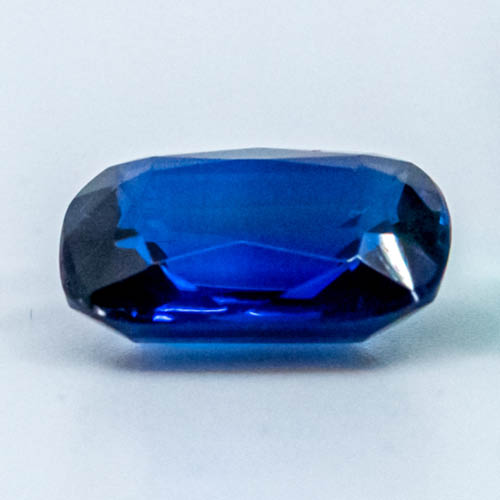
In our society, diamonds are considered to be THE most valuable gemstones of all. However, diamonds are actually relatively rare. Nevertheless, the diamond, together with the colored stones emerald, sapphire and ruby, is one of the four major gemstones.

RUBINE
Rubies are generally considered to be the most valuable gemstones. Derived from the Latin "ruber", rubies are red stones made from the mineral corundum. The more intense the red of the stone, the more sought-after it is. The most valuable stones are strong red rubies with a slightly bluish tinge. Stones in this color variation are known as pigeon's blood rubies and are particularly sought-after as investment gemstones.
Rubies of the highest quality are mainly mined in Burma. They are also found in Thailand, India and Sri Lanka. High-quality rubies also come from East Africa, particularly Kenya and Tanzania. Rubies are usually facet cut, and more rarely cabochon cut.

SAPHIRE
While red corundum is referred to as a ruby, other color variations of the mineral are known as sapphires. The color spectrum ranges from white stones to yellow, orange, brown, green or blue sapphires. Pink-colored stones are also usually classified as sapphires, although the boundary to rubies is blurred here.
However, blue sapphires are the most sought-after, with the "cornflower blue" shade and the "paparadscha" color combination making the hearts of gemstone collectors beat faster. Star sapphires are a special variation in which enclosed crystal fibers, needles or channels create a star effect known as "asterism". If light falls on the stone at the right angle, a cross or star appears to sparkle inside the stone.
High-quality sapphires from India and Sri Lanka fetch the highest prices, but stones from Madagascar are also of very good quality. A wide variety of cuts are commonly used for sapphires. Facet cuts, such as the cushion cut or brilliant cut, are common, but smooth cuts are also used for star sapphires to bring out the asterism.

SMARAGDE
The third "large" colored gemstone is the emerald. The green gemstone is a variation of the mineral beryl, which gets its green color from the elements chromium and vanadium. Other representatives of the beryl group are the blue aquamarine, the pink morganite, the yellow gold beryl and the colorless goshenite.
The highest quality stones come from Colombia. However, there are also emerald deposits in Austria. The Habach Valley in Salzburg's Pinzgau region is home to the only relevant emerald deposit in Europe. Emeralds from the Austrian Alps can be found in the imperial court regalia, which can be viewed in the Imperial Treasury in Vienna. Emeralds are usually cut in the emerald cut named after them.

DIAMONDS
Diamonds are a special crystalline form of pure carbon that was exposed to enormous pressure and high heat in the earth's crust. Diamonds are colorless or have a slight yellowish tint due to nitrogen. If the hue of a diamond exceeds GIA color grade Z or if a stone has a different color, it is considered a "fancy diamond" or color diamond. In this case, the more intense the color, the rarer and therefore the more valuable it is.
Diamonds have now been found on all continents, but the most significant deposits are in Russia, southern Africa - especially Botswana & Congo - , Canada and Australia. The main diamond trading centers are Antwerp in the Netherlands, Israel and Mumbai. The best-known diamond cut is probably the brilliant cut, which reflects the incident light to the maximum and therefore promises a very good "light yield".
Value of ruby, sapphire, emerald & diamonds
Unlike pieces made of gold, silver and other precious metals, whose price can be calculated primarily from their pure weight and the current price of gold, the value of colored gemstones depends entirely on the individual piece and its quality.
In addition to weight (carat) and color (color), clarity and cut are also decisive for the value. Investment-quality stones also require a certificate from the most widely recognized institute possible, such as the GIA (Gemological Institute of America). These institutes not only vouch for the authenticity of the stone, but also evaluate and categorize the individual piece within various scales.
Another quality criterion is post-treatment. While the cut of a gemstone should ensure that the fire of a stone is shown to its best advantage, other post-treatments are considered to reduce quality. Various treatments are used to improve gemstones of inferior quality. Heat treatment, for example, is intended to intensify the color of the stones, while resins or glass fillings are used to conceal flaws in the stone. To be of interest as a gemstone investment, a stone must be untreated.
Would you like to buy or sell colored gemstones - rubies, sapphires or emeralds?
Gold & Co founder Walter Hell-Höflinger is a sworn and court-certified expert for precious metals and jewelry, a European gemologist and a specialist member of the Austrian Gemmological Society. On all Wednesday afternoons, Mr. Hell-Höflinger is available to answer your questions about gemstones and to value your treasures. Please make an appointment for larger quantities.
Would you like to buy or sell gemstones?
Our gemologist is available for valuations every Wednesday afternoon. Please make an appointment for larger quantities.










